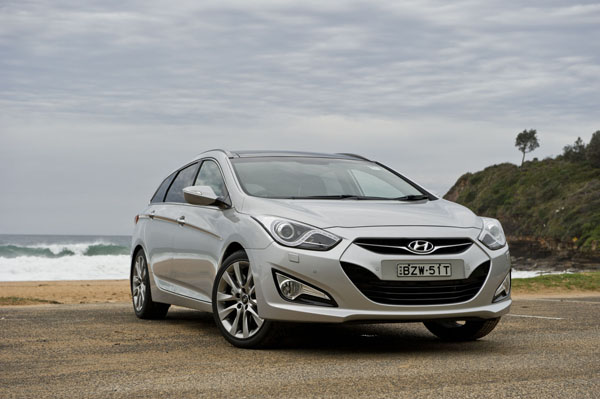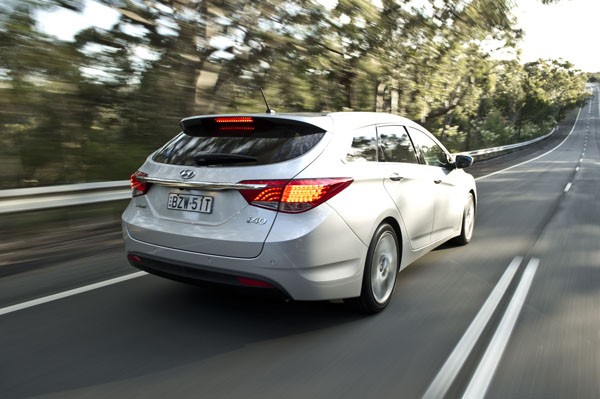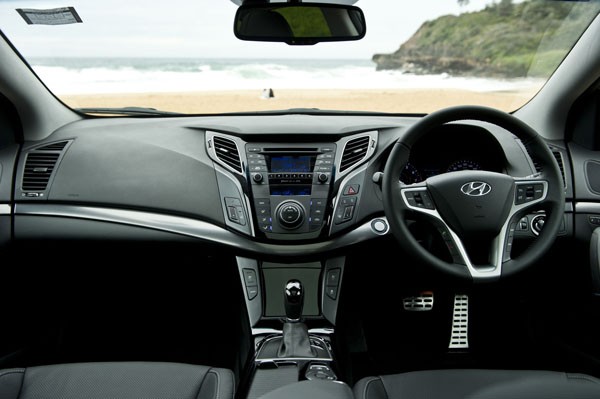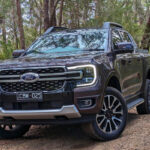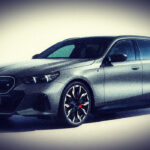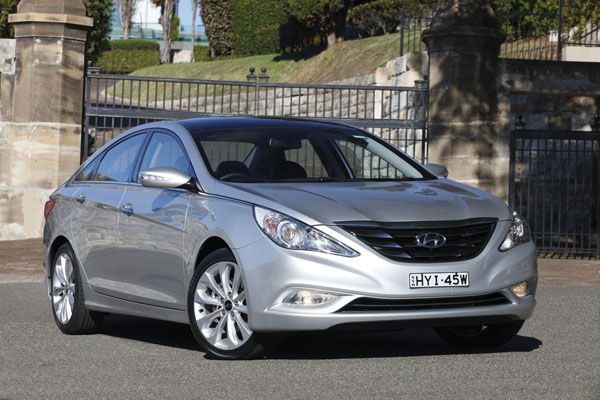The family wagon is under siege in Australia – and losing. Jacked-up SUVs are often less roomy and certainly less wieldy than your average wagon and to add insult to injury, have smaller boots.
The i40 gets a bit lost in the Hyundai range – bigger than the Tardis-like i30 Touring (our beloved long-termer) and slotted in between the ix35 and Santa Fe price-wise, it also has the new Sonata to deal with and compete with the sedan version.
Does it deserve its relative obscurity?
VALUE
The i40 Touring range starts at $33,990 for the Active 2.0-litre petrol with the range-standard six-speed automatic. Another $2600 upgrades to the 1.7 diesel, a pattern repeated with the $38,990 Elite and $44,990 Elite.
The top of the range $47,590 diesel Premium was our steed for the week. Before we get into the spec list, it’s worth pointing out, it’s not exhaustive. Even after a week of heavy visiting-family shuttling, we were still finding new features.
The highlights are: dual zone climate control, six-speaker stereo, rear vision camera, keyless entry and start, cruise control, lane departure warning with steering assist, leather trim, electric heated and cooled front seats, sat-nav, full glass roof, automatic HID headlights, auto wipers, dark tint windows, park assistance, power tailgate and power windows and mirrors.
Metallic paint is a $595 extra (which is a bit cheeky for nearly $50,000 on the road for a Hyundai).
DESIGN
The Hyundai i40 is a cracking-looking car. The sedan is handsome but goes a bit wobbly at the back whereas the wagon maintains the rage. Low and sleek, there are echoes of Mercedes shooting brake styling and a Jaguar XJS-like flourish in the brightwork at the rear.
The 18-inch alloys are free of the nasty plastic-chrome inserts of some other Hyundais and properly fill the huge arches. The LED fishhook daytime running lights are distinctive and lend the i40 a very European air, which is entirely intentional.
Like its i30 sibling, it’s gigantic inside. Special mention must be made of the rear seat space – the legroom is epic. With the front seats set for six-footers, there’s still limo-like room for the rear passengers. Headroom is good even with the glass roof that stretches back over the rear passenger’s heads and the boot held two big Samsonsites side by side and two huge soft sports bags stacked on top of each other.
The dash design is familiar to Hyundai owners from the i30 right up through to the Santa Fe. The family look is perfectly agreeable with brushed metallic finishes and satin plastics. The materials are certainly no match for VW but are comfortably better than most of its competitors.
SAFETY
The boot features a cargo cover, barrier net and cargo system for keeping smaller items from flying around. Beneath the flat floor is a few little cubby holes where you could hide stuff like iPads, phones and laptops.
There are nine airbags, ABS, corner braking control, brake force distribution, lane departure warning, blind spot warning, brake assist and ISOFIX mounting points.
The i40 has gained five ANCAP stars.
INFOTAINMENT
The six-speaker stereo is controlled from a seven-inch touch screen which also looks after sat-nav and reversing camera duties. The interface is still a bit clunky but seems to be improving as the years go by, with a bit of impatient stabbing to make things work and a slightly counter-intuitive way of programming the sat-nav.
The sound is good from the speaker set but won’t be exciting any audiophiles.
The Bluetooth phone audio quality is good and you can plug your phone into USB as well.
ENGINE / TRANSMISSION
The 1.7-litre turbo-diesel produces 100 kW of power and thumping 330Nm of torque. The transmission is Hyundai’s own six-speed automatic. Conspicuous by its absence is stop-start fuel saving technology. Hyundai claims 5.6 litres on the combined cycle but like the i30, we got a solid miss, using 8.6 litres per hundred kilometres.
DRIVING
You couldn’t accuse the Hyundai i40 of being the quietest, smoothest or most dynamic car on the road. The 18-inch alloys do shake up the ride compared to the smaller wheels on the Active and the fatter tyres roar.
The engine is vocal under load and the i40 won’t be troubling a race track anytime soon.
What it is, however, is a comfortable and surprisingly luxurious family car.
The driving position is just right, with a good view out over the diving bonnet and ample adjustment to get comfortable.
Heated and cooled seats keep your posterior at the right temperature, you can open the roof blind or the roof itself to let in a massive amount of light and the climate control fends off the worst excesses of Sydney humidity.
The torquey 1.7 diesel is terrific at pulling a car full of people and luggage, barely breaking a sweat. There is a selectable driving mode, but the Eco mode is too soft and Sport mode a bit coarse – it just seems to hold too low a gear for too long. Leave it in Normal and it’s a perfectly acceptable state of affairs.
The steering is a little vague, isolating you almost completely from what’s going on outside, but there is a bit of heft to keep you connected. If you get a bit ambitious, the traction and stability controls are a bit of a hindrance – as with all Hyundais there’s a near-binary attitude to cutting the power when there’s any wheelspin and the computer is loathe to hand it back.
The i40 does feature corner brake control, which means that if you do switch off the nannies, there’s a very good chance you can have a moderate amount of fun without getting into too much trouble. It’s unlikely many i40 buyers will ever sink the pedal, but it’s comforting to know it can do it.
The i40 isn’t about that, though – it’s an easy, comfortable cruise-and-commute car.
SUMMING UP 3.5/5
Prospective Uber drivers should take note, you’ll have happier passengers in this car than almost any other for the price. It’s certainly going to be cheaper to own and run than an SUV with more interior space than many much larger cars (including, we think, Hyundai’s own Genesis).
It certainly doesn’t deserve its relative lack of interest – the i40 is great to look at and be in, it’s a terrifically comfortable car packed with tech goodies and features to ensure you arrive unstressed.
If you want a car with lots of boot space and room for lounging teenagers, this is a better bet than an SUV.
Likes: Great looks, ample interior space, lots of goodies
Dislikes: Jumpy traction control, fiddly sat-nav, glass roof heats the cabin
AT A GLANCE
MODEL RANGE
Active 2.0-litre petrol: $33,990 (automatic)
Active 1.7-litre turbo-diesel: $36,590 (automatic)
Elite 2.0-litre petrol: $38,990 (automatic)
Elite 1.7-litre turbo-diesel: $41,590 (automatic)
Premium 2.0-litre petrol: $44,990 (automatic)
Premium 1.7-litre turbo-diesel: $47,590 (automatic)
Note: These prices do not include dealer or government charges. Contact your local Hyundai dealer for drive-away prices.
FEATURES
ABS Brakes: Standard in all models
Automatic Transmission: Optional in Active, standard in Elite and Premium
Cruise Control: Standard in all models
Dual Front Airbags: Standard in all models
Front Side Airbags: Standard in all models
Electronic Stability Program: Standard in all models
Rear Parking Sensors: Standard in Elite and Premium
Reversing Camera: Standard in Premium
USB/Auxiliary Audio Inputs: Standard in all models
Bluetooth: Standard in all models
Steering Wheel Mounted Controls: Standard in all models
SPECIFICATIONS (Hyundai i40 Tourer 1.7-litre turbo-diesel five-door wagon)
ENGINE:
Capacity: 1.685 litres
Configuration:Four cylinders in line
Head Design: DOHC, four valves per cylinder
Compression Ratio: 17.0:1
Bore/Stroke: 77.2 mm x 90.0 mm
Maximum Power: 100 kW @ 4000 rpm
Maximum Torque: 320 Nm @ 2000-2500 rpm
DRIVELINE:
Driven Wheels: Front
Manual Transmission: Not offered
Automatic Transmission: Six-speed
Final Drive Ratio: 2.885:1
DIMENSIONS, WEIGHT AND CAPACITIES:
Length: 4770 mm
Wheelbase: 2770 mm
Width: 1815 mm
Height: 1470 mm
Turning Circle: 10.9 metres
Kerb Mass: 1420-1574 kg
Fuel Tank Capacity: 70 litres
Towing Ability: 650 kg (1700 kg with braked trailer)
Boot Capacity: 553 litres (1719 with rear seatbacks folded)
SUSPENSION AND BRAKES:
Front Suspension: MacPherson struts
Rear Suspension: Multi-link
Front Brakes: Ventilated disc
Rear Brakes: Disc
FUEL CONSUMPTION:
Type: Diesel
Combined Cycle (ADR 81/02): 4.7 L/100km
GREEN VEHICLE GUIDE RATINGS:
Greenhouse Rating: 8/10
Air Pollution Rating: 6/10
STANDARD WARRANTY:
Five years/unlimited km




